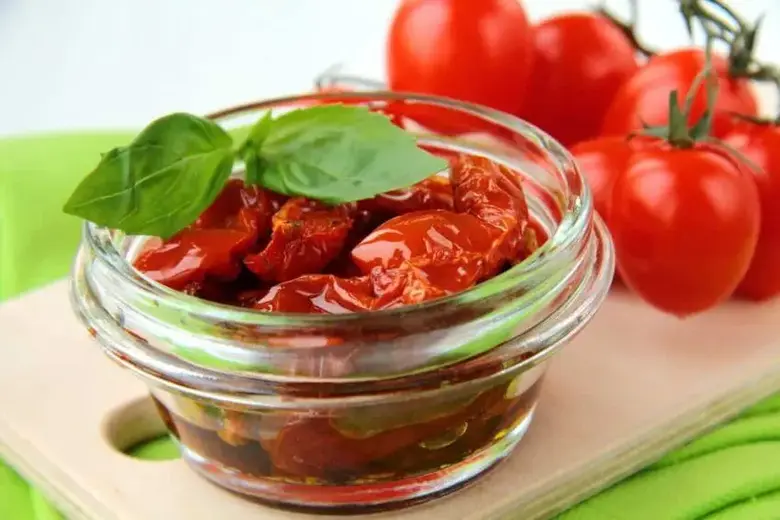Do sun-dried tomatoes need to be refrigerated?

A very common problem that we often come across is the excessive purchase of cherry tomatoes. They are such a delicious and versatile ingredient, but they don’t seem to last very long. After a short time, they begin to enter the overripe phase, in which they are not very pleasant to consume.
One of the most popular solutions is to make dried tomatoes. Unfortunately, they also seem to go bad quickly even if you store them in a cool, dark place, as the purchased packaging indicates. So you may be wondering about storage and refrigeration needs.
Do sun-dried tomatoes need to be refrigerated? If your sundried tomatoes are packed in oil, they will need to be stored in the fridge to keep for 2-3 weeks after opening. If they are only dried tomatoes without any type of preservative, they can be stored in any dry and cool place.
In this article, we’ll discuss the various ways sun-dried tomatoes should be stored to keep them as long as possible, and why they should be stored that way.
What are dried tomatoes?
Sun-dried tomatoes are just what the name suggests: sun-dried tomatoes.
But don’t confuse them with dried or dehydrated tomatoes , since these are dried in an oven, not in the sun. There is also a big difference in flavor, as well as the elements the tomatoes were exposed to.
Sun-dried tomatoes are made from any type of small tomato (usually cherry) that has become too ripe and cannot be sold as a fresh tomato. They are chosen for their wrinkled skin and soft texture. They have already started to lose some moisture.
First of all, the tomatoes are cut in half or into quarters. They are then treated with salt to extract as much moisture as possible. This also helps preserve its color, acts as a preservative, and adds a salty flavor.
The tomatoes are then placed in the sun to dry for 4-10 days.
After the drying process, they are packaged in various ways. This container is the one that will determine what type of dried tomato you have, and how you should preserve it.
Types of dried tomatoes
- The first way to can these tomatoes is to place them as is in an airtight container without any other ingredients. They are labeled simply as “dried tomatoes”.
- Another more common way to preserve them is in olive oil. They are often referred to as “dried tomatoes in oil.” Olive oil acts as a preservative and flavoring at the same time.
- Sometimes other ingredients, such as herbs, garlic, ginger, or whole spices, are also added to olive oil to give them a unique flavor.
Conservation of dried tomatoes (normal)
Once again, by sun-dried tomatoes we mean tomatoes without any other ingredients. The key to preserving these types of sun-dried tomatoes is to keep them away from oxygen.
Since the tomatoes have been sun-dried in a very low temperature environment for a long time, bacteria will be able to reach the tomatoes, no matter how hygienic the environment is.
Bacteria thrive on oxygen and moisture , so by eliminating those two factors you can prevent mold from growing even if there are bacteria on them.
Place these tomatoes in a resealable bag, mason jar, or airtight plastic container. Do not store in metal containers, as they will absorb the metallic flavor and color.
Make sure the container or bag has as little air in it as possible, either by squeezing the air out or by packing the container tightly.
These dried tomatoes can be stored in a cool, dry, dark cabinet for up to one year. Once opened, they will last 4-8 weeks, depending on their moisture content and exposure to the elements.
Preservation of dried tomatoes packed in oil
Sundried tomatoes in oil do not keep as long as regular sundried tomatoes. Their useful life ranges from 1 to 2 years if they are not opened. If the package is unopened, it can be stored in a cool, dark place.
But, once opened, they have about 2-3 weeks before going rancid. Tomatoes packed in oil should be stored in the refrigerator.
This also applies to any type of sun-dried tomatoes that contain other ingredients. Fresh herbs, spices or garlic naturally contain bacteria that will multiply when exposed to heat and humidity.
The fridge will cause the olive oil to solidify and turn white, but this is easily corrected. When you’re ready to use or eat your tomatoes, just leave the packet on the counter for about 30 minutes and the oil will return to a clear liquid.
Check the package weekly for mold or musty smells.











